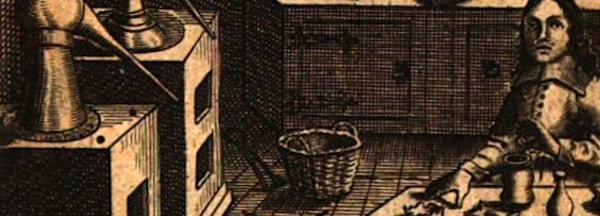Jean Beguin, Paris, 1610 (Google Books, 1656)

In January 1664/5, Lister continued his reading in chymistry, perusing the Tyrocinium chymicum, ‘the most influential and popular chymical textbook published in the first half of the seventeenth century’. 1.
The work was written to teach chymistry to apothecaries and medical practictioners, originally written by Beguin to save him the trouble of dictating to his pupils during lectures. 2. Beguin was a native of Lorraine and an apothecary practicing in the early seventeenth century, establishing a school of pharmacy in Paris under the protection of Jean Ribit, the physician to the King. Ribit and Turquet de Mayerne obtained for Beguin permission to establish a laboratory and to give public lectures on chymistry teaching the preparation of spagyrical medicines. 3. Beguin promoted a corpuscularian explanation of spagyria (analysis and synthesis) taken from Andreas Libavius and Paracelsus. 4.
Beguin would need patronage for his school, as in France there was strong opposition from the Sorbonne to the use of chemical medicines, particularly to the use of antimony in treatment — the so-called ‘antimony wars’ between chymical physicians and followers of Paracelsus and the traditional Galenic doctors. The Paracelsians argued that toxic substances like mercury or antimony could be freed of their poisonous elements using chymical procedures and be transformed into beneficial medicines. The Galenists argued such substances were noxious to the body, and instead promoted traditional treatments like emetics and bleeding to restore humoral balance. As Principe has indicated, ‘The battle in France came to an end only after 1658, when Louis XIV, having fallen ill during a military campaign . . . was cured by a vomit induced with a dose of antimony administered in wine by a local physician’. The Parisian medical faculty then ‘had little recourse but to vote in favor of legalizing the use of this Paracelsian vin émetique’. 5.
Cardinal Richelieu also recognized the efficacy of these chymical treatments and began to patronize chymical physicians at Court. By the time Lister read Beguin’s book, Paracelsian and chymical treatments were relatively accepted by practitioners, and he must have found Beguin’s work of great practical value.
Lister later donated a copy of this book to Oxford.
- William R. Newman and Lawrence M. Principe, ‘Alchemy vs. Chemistry: The Etymological Origins of a Historiographic Mistake’, Early Science and Medicine 3, 1 (1998), 32-65, on 49 ↩
- T.S. Patterson, ‘Jean Beguin and his Tyrocinium Chymicum’, Annals of Science 2, 3 (1937), 243-298, on 247 ↩
- Patterson, ‘Jean Beguin and his Tyrocinium Chymicum’, 245 ↩
- William R. Newman, Atoms and Alchemy: Chymistry and the Experimental Origins of the Scientific Revolution (Chicago: University of Chicago Press, 2006), 79 ↩
- Lawrence Principe, The Secrets of Alchemy (Chicago: University of Chicago Press, 2012), 130 ↩
